 IBM (NYSE: IBM) researchers today announced an advancement in computer-based simulations that is helping to drive chip technologies to new heights of performance and function. As reported in the scientific journal Physical Review Letters, a team of scientists at IBM's Zurich Research Laboratory for the first time used advanced supercomputer-based models to more deeply understand and master the complex behavior of a promising new material -- hafnium dioxide -- in silicon transistors, the fundamental building blocks of computer chips.
IBM (NYSE: IBM) researchers today announced an advancement in computer-based simulations that is helping to drive chip technologies to new heights of performance and function. As reported in the scientific journal Physical Review Letters, a team of scientists at IBM's Zurich Research Laboratory for the first time used advanced supercomputer-based models to more deeply understand and master the complex behavior of a promising new material -- hafnium dioxide -- in silicon transistors, the fundamental building blocks of computer chips.The new material is key to the company's recently-announced "high-k metal gate" technology, the first major change to the transistor since the emergence of silicon semiconductors, promising enhanced chip performance to benefit computers and other electronic systems. IBM is implementing the technology and will apply it to products in 2008.
The semiconductor industry has long sought to find a new material for a crucial part of the transistor known as the gate dielectric, which, with the materials used currently, is limiting the industry's ability to keep pace with the progress predicted by Moore's Law -- a maxim predicting a doubling of the number of transistors on a chip, and an associated increase in chip performance, every 12-18 months.
While hafnium dioxide appeared to be an ideal candidate for next-generation transistor gates, the introduction of any new material in semiconductors can have unforeseen consequences, so it must be thoroughly understood beforehand. One critical factor contributing to IBM's success in the highly complex and difficult task of integrating these new materials has been simulation of the interaction of this material at the atomic level.
Scientists at IBM's Zurich Research Laboratory have used their long-standing expertise in computer-based modeling, together with the capabilities offered by the IBM Blue Gene supercomputer, to determine why hafnium dioxide works so much better than other high-k materials previously considered by the industry. As a result, the researchers were able to gain a clear picture -- for the first time -- of the underlying physics driving the unique electrical behavior of hafnium dioxide when it mixes with silicon, as observed in laboratory experiments, shedding light on the reasons that make this material unique as gate dielectric.
For this study, the IBM team simulated various material compositions using 50 different models of hafnium silicates, materials that form when silicon and hafnium oxides mix. These models contain up to 600 atoms and approx. 5,000 electrons, representing a realistic system. A single calculation of the dielectric constant was accomplished in only five days of computing time on the two-rack Blue Gene/L supercomputer (4096 processors) installed at the Zurich lab's site. The complete simulation for all 50 models, approx. 250 days on Blue Gene, would normally take the most powerful laptop PC an astounding 700 years to calculate. This corresponds to a staggering 200 billion billion (2 x 10^20) operations.
This work illustrates how supercomputing modeling techniques are bringing technologies of all kinds to a new level. Computer simulations have been possible since the 1980s, but only now -- thanks to the evolution of algorithms and their mapping to such an extremely scalable and balanced architecture as that of the Blue Gene computer -- scientists are able to tackle these types of problems by creating realistic models with several thousands of particles, starting only from the laws of nature.
"Advances in algorithms and their optimal mapping on extremely large and scalable computer hardware such as Blue Gene are empowering us to do accurate and realistic atomic simulations of complex materials," explains Alessandro Curioni, supercomputing expert from IBM's Zurich lab and emphasizes: "So indeed, today we are able to use supercomputers to investigate materials that will be eventually used in the next generation of supercomputers."
The approach used by the IBM team is called ab initio molecular dynamics, where the interactions between the particles of the system are derived from the basic laws of physics without employing any empirical data. In the course of their ground-breaking work, the IBM team created more than 50 realistic virtual models of the hafnium silicates with various concentrations of hafnium on the supercomputer. They then simulated the evolution of these structures over a given time period, estimated their dielectric constants and used these results to rationalize experimental findings.
The advantage of computer-based simulations is that, being virtual, they are free of the problems inherent to laboratory experiments, such as the effects of preparation conditions, the purity of the compounds, or the presence of parasitic reactions. Most importantly, with the simulations one can follow what the individual atoms are doing. Computer simulations allow the "intrinsic" and ideal characteristics of a material to be calculated and correlated directly with the structure at an atomic level.
About the IBM Zurich Research Laboratory
The IBM Zurich Research Laboratory (ZRL) is the European branch of IBM Research. This network of some 3200 employees in eight laboratories around the globe is the largest industrial research organization in the world. ZRL itself currently employs about 320 people, representing more than 30 nationalities.
ZRL's Computational Biochemistry and Materials Science group is among the worldwide leading research teams in this field, and is active in the development of accurate and efficient methodologies for the simulation of diverse materials, ranging from silicon to enzymes, at the atomic level. Since August 2005, the team uses a two-rack Blue Gene/L system, with a peak performance of 11.2 Teraflops, installed on the ZRL site, making it the second fastest supercomputer in Switzerland.
www.zurich.ibm.com/deepcomputing
No comments:
Post a Comment